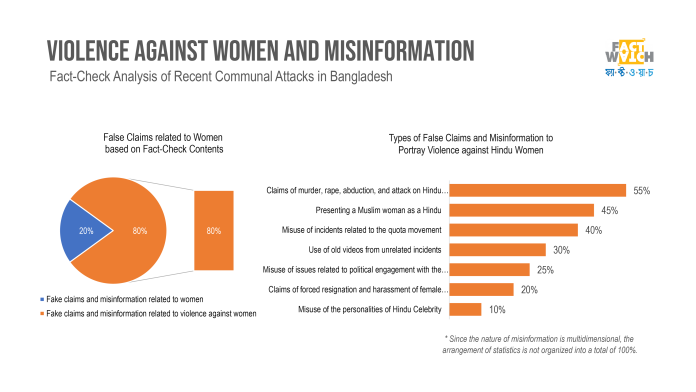The rapid dissemination of false claims targeting Hindu women reveals the dangerous intersection of how gender and religion are used during political instability
This article was published in the Dhaka Tribune on September 13, 2024.
The resignation of Sheikh Hasina on August 5 and the subsequent collapse of the Awami League government caused a sudden power vacuum which provided a fertile ground for political tensions, as attacks took place on homes and establishments belonging to people of different religions.
Hindu communities have also been targeted in some cases. Subsequently, several Indian media outlets have circulated accounts of widespread attacks against the Hindu community in Bangladesh, raising serious concerns about the ulterior motives behind these reports.

Portraying violence specifically against Hindu women, the spread of false claims played a significant role in fueling communal tensions during the quota reform movement and after the downfall of the Awami government.
Was that the deliberate targeting of women in misinformation campaigns an intended move to incite communal violence? How do women become prime targets of disinformation disguised as victims of attacks during times of conflict and unrest?
However, Fact-Watch, an independent fact-checking organization, reviewed false claims about violence against minority women and how they were exploited as symbolic victims in these narratives to incite further division and unrest.

This review involved analyzing over 25 fact-check reports from various institutions and print media in Bangladesh and India, from July 1 to August 31, with a focus on identifying patterns of misinformation related to communal violence and violence against women.
More than 50 accounts on X, 72% of which were based in India, played a key role in spreading misinformation by circulating images, videos, and content about recent events in Bangladesh, often framing them in a communal context that stoked fear and division among different religious communities.
In 80% of the reports, inaccurate allegations and misinformation about violence against women were found.
The fact-checked reports highlighted several recurring patterns of violence against women and the spread of misinformation. Old videos and images from past incidents have been repurposed to create false claims of violence against women, with political violence often portrayed as religious or ethnic attacks. Likewise, false claims of celebrity assaults and attacks on homes have been spread to incite communal tensions, while harassment of female teachers has been misrepresented as evidence of religious persecution.
On the other hand, 55% of the disinformation content portrayed Hindu women as victims of violence, including murder, rape, and abduction. In comparison, 45% depicted Muslim women as victims under the guise of being Hindu.
Equally, protests during the student quota movement were misleadingly framed as attacks on Hindu women in 40% of the content. However, 30% used old, unrelated videos to falsely claim communal violence, with no actual evidence of attacks on minority women.
Less obvious is the fact that only 15% of the content actually involved incidents with Hindu women, and these events were unrelated to gender-based violence or communalism. Compared to other cases, political violence was also manipulated, with 25% of the reports falsely claiming that female members of the Awami League’s student wing were attacked as Hindu women.
Furthermore, 20% of the content falsely claimed that Hindu female teachers were forced to resign under pressure. Despite this, videos of Muslim teachers being harassed were misrepresented as Hindu incidents, fueling further disinformation.
Misinformation is the frequently used tool to fuel communal tensions; however, findings show that the victimhood of Hindu women is being portrayed as the root cause of communal violence. The use of false videos and images has been circulated to create the perception that the Hindu community is under constant threat.
It makes women more vulnerable while also marginalizing religious minorities, creating a lasting obstacle to social harmony and stability
False claims regarding the rape of a Dalit Hindu woman and the misuse of old videos depicting sexual assault are sensitive examples of how disinformation is weaponized. Incidents involving Hindu women, such as false reports of forced resignations of teachers and abductions, are exaggerated or fabricated to stir communal tensions.
Similarly, prominent figures have been falsely implicated, portraying Hindu women as the main victims of communal violence. These narratives have diverted attention from the actual political events, such as attacks on female leaders during anti-government protests, which were spun as communal violence against Hindu women.
The rapid dissemination of false claims about women during political instability shows how gendered disinformation is used to gain public sympathy and provoke communal tensions.
False claims of sexual violence involving old videos being linked to recent incidents were identified as a tactic used to create sensationalized content both for social media platforms and media outlets. These false claims unequivocally fuel communal division by consistently portraying the Muslim community as aggressors against Hindus.
The spread of misinformation targeting Hindu women reveals the dangerous intersection of gender and religion in these contexts. It makes women more vulnerable while also marginalizing religious minorities, creating a lasting obstacle to social harmony and stability.
Religious misinformation frequently weaponizes gender-based violence to justify attacks; however, the spread of false narratives targeting Hindu women, which exposes their safety and rights, was strategically employed to incite communal violence, ultimately contributing to prolonged societal unrest.
This highlights the urgency of addressing the nature and impact of this misinformation to protect vulnerable groups from being used as pawns in political and religious conflicts.
This review demonstrates that gendered misinformation not only disregards women’s status but also curtails their political participation. On the whole, the use of gendered misinformation as a tool to promote communalism is alarming, requiring ongoing vigilance to combat these harmful narratives.
Most importantly, the portrayal of violence against Hindu women has reframed communal violence as a regional issue, creating a complex set of dual barriers in society.
On the one hand, this narrative further marginalizes women by exploiting their victimhood for political purposes.
On the other hand, it deepens communal divides, positioning religious minorities as targets and fueling inter-religious tensions.
By strategically exploiting the vulnerabilities of women in the context of communalism, it is essential to critically examine and challenge these false narratives to promote societal stability and gender equality.
Zulker Naeen is a Research Coordinator at the Centre for Critical and Qualitative Studies, at the University of Liberal Arts Bangladesh. He is reachable at naeenzulker@gmail.com. This report is drawn from research findings on “Violence Against Women and Misinformation: A Fact-Check Analysis of Recent Communal Attacks in Bangladesh” by the author, as part of a working paper published by Fact-Watch.









